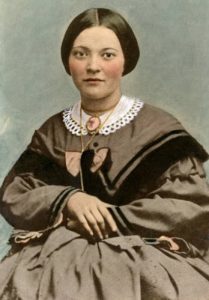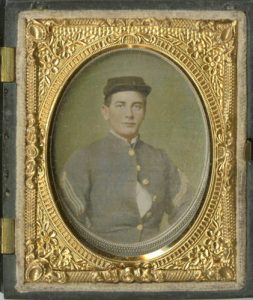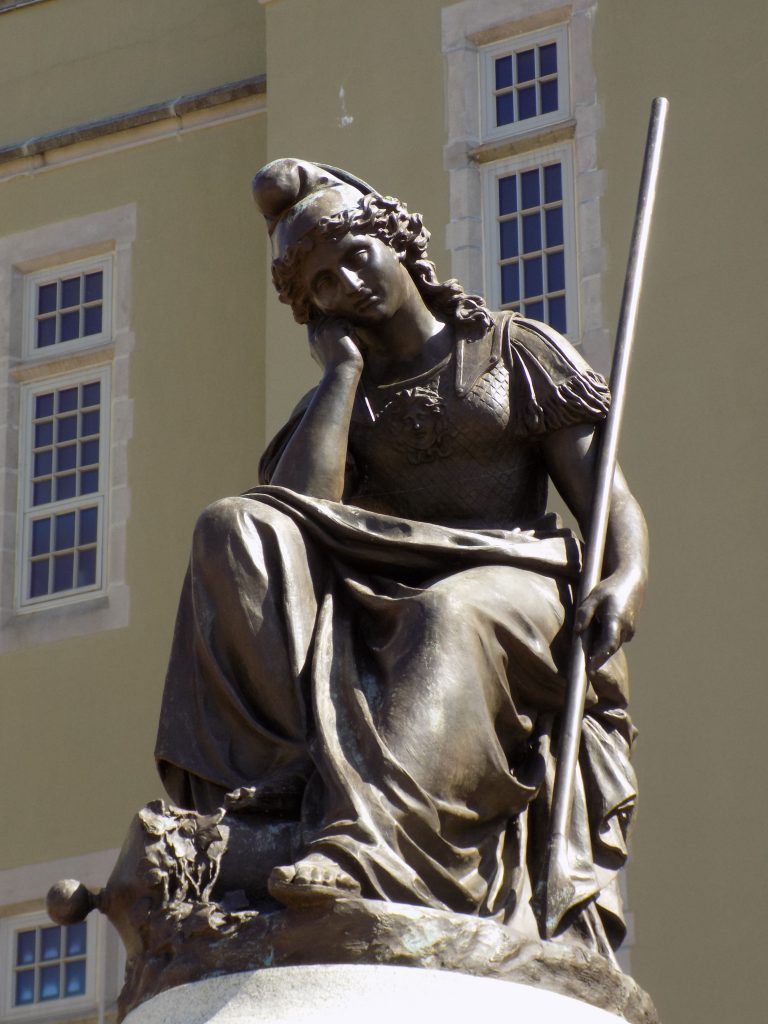Lydie Clinedinst & Moses Ezekiel: A Devoted Friendship Begun at New Market

Tears blurred the candlelit scene. Seventeen-year-old Thomas Garland Jefferson struggled for his final breaths. Former roommate and battlefield comrade—Moses Ezekiel—supported the dying cadet’s body while nearby a young civilian woman—Eliza Clinedinst—held a candle. Eliza’s sister, Anna, her mother, and the VMI colorbearer also witnessed the sad scene. Ezekiel and Clinedinst had both witnessed the Battle of New Market first-hand, one on the battlefield and the other from the back porch of her home. Now, in the darkened room, they saw the effects of war: a war that would profoundly affect the future of these two individuals who would live to memorialize and remember the role of the cadets at New Market and the mourning scene at Jefferson’s deathbed.
Eliza Clinedinst, known as “Lydie” to her family and friends, was twenty-six years old in 1864. Unmarried and living with her family in their home on Congress Street, she apparently had not taken refuge in a cellar by the time the Corps of Cadets moved down Shirley Hill. The Clinedinsts’ back porch offered a clear view of the slope, and when her brother called her to come and see, Lydie rushed to the porch in time to see: “The fine soldiers coming down Shirley’s Hill…They (Cadets) looked so nice and trim as they ran down the hill.” At the time, Lydie did not know the soldiers she saw were VMI cadets; she and others initially thought a French detachment had arrived to fight for the Confederacy.

The truth soon became apparent as wounded cadets made their way into town, seeking aid and finding refuge at the Clinedinst home. Lydie Clinedinst may have been one of the first civilians of New Market to venture onto the battleground near Shirley’s Hill, trying to bring aid to the injured soldiers. Late that night, a barefoot, weary, nineteen-year-old cadet knocked on the Clinedinst door, begging for a quiet and comfortable place to bring his badly injured friend. When her mother agreed to assist, Lydie found a new patient in her home: Cadet Thomas Garland Jefferson.
After Jefferson’s death on the night of May 18, Lydie wrote to Jefferson’s family and made the eighty mile journey to return some of his personal effects. It started her friendship with the Jefferson family that lasted the remainder of her lifetime, including pages of correspondence and at least one lengthy visit. It also marked the beginning of her close connection to the VMI Cadets and how their history would be remembered in New Market. Through the months and years, Lydie managed to stay in contact with many of the VMI Cadets who fought at New Market, writing letters and often remembering that moment she saw the Corps on the hillside.
In 1873, Lydie married John William Crim, a Confederate veteran who had fought with McNeill’s Partisan Rangers during the war. Her last name might have changed, but she stayed in New Market and remained devoted to her friendships and to her interest in Virginia Military Institute. Lydie Crim had a daughter, but her adoptive sons were the VMI cadets whom she often called “her boys.” Because of her close connection to the institute, her care for the veteran cadets, and interest in the incoming classes, she received the New Market Cross of Honor which was bestowed on every New Market cadet.
As the decades passed, Lydie grew older and more interested in the memory of the battle of New Market. She attended every memorial day ceremony, monument dedication, and veteran reunion that she could. If veteran cadets could not attend, Lydie sent detailed accounts and descriptions of the happenings, including how the Yankee visitors and veterans were treating the dear old Southern boys. Proudly, Lydie wore her Cross of Honor and delighted to tell veteran and youngsters alike how she had seen the cadets in battle and how she had taken care of their wounded. Sometimes in her old age, her stories strayed from verifiable truth, but nothing could dampen her pride in “her boys.” When Eliza Clinedinst Crim died in 1931, an honor guard of VMI Cadets bore her body to Emmanuel Lutheran Cemetery while hundreds of people gathered to honor her life and continued kindness. Her headstone reads “Mother of the New Market Cadets.”

One of “her boys” stayed in close and regular contact with Mrs. Crim for decades, even when their correspondence had to cross continents and oceans. Moses Ezekiel, the young man who knocked on the door and who looked after Cadet Jefferson, embarked on a journey and career that took him far from New Market.

Moses J. Ezekiel had arrived at VMI in 1862, the first Jewish-American cadet accepted at the institute. Already interested in the arts, he participated in cultural activities in Lexington, including the debating society, and sketched images whenever he could. Following the battle of New Market and his friend’s death and burial, Moses journeyed to his hometown, Richmond, with the Corps of Cadets. After Hunter’s Raid and the subsequent burning of VMI, Moses re-gathered artwork that had been dispersed around the area and tried to return it to the original owners. He stayed with the cadets and acted as orderly sergeant while they held lines south of Richmond, then graduated from VMI in 1866. An imprudent letter about General Grant obtained by the press put Moses in danger after the war, but he managed to escape detection and then headed west to Cincinnati, obtaining a job in an art studio.
After gaining local and regional applause for his work, Moses decided to study and create abroad; Europe was the cultural center of the arts and the place for aspiring artists and classical creators. Berlin, then Rome welcomed the former VMI cadet as he studied with masters and began sculpting his own renowned pieces. At age twenty-nine, Moses Ezekiel won the prestigious Michel-Beer Prix de Rome, winning with his bas relief Israel.

Early in his European travels, Moses “modeled…the ¾ life sized figure of Virginia Mourning her Dead and sent Mrs. General Lee a photo of it, as I was always in correspondence with that estimable wife of our Great Hero. That statue I have always kept and it is now in my studio here, and is the model of the statue my brother cadets were good enough to unveil at the parade ground of our Alma Mater last year.”
It took years before Virginia Mourning Her Dead was full created, cast, and placed in a place of honor at Virginia Military Institute. In 1903, the figure of a grieving woman in classical garments was unveiled to watch and weep over the graves of the fallen VMI Cadets—including Thomas Garland Jefferson.
Moses spent most of his career in Europe, creating beautiful pieces of art on international commissions, and receiving many honors from heads of state, including an Italian knighthood. However, even with his titles and success, New Market and Virginia Military Institute were never far from his mind. In 1904 in a private letter, Moses explained his affection for “the V.M.I., where every stone, and every blade of grass is dear to me- and the name of Cadet of the V.M.I. the proudest and most honored title I can ever possess.” That same year he received his New Market Cross of Honor.
Sir Moses Ezekiel died in 1917 in Rome, Italy, but he had wished to be buried in the United States. Several years after the conclusion of World War I, his remains were brought to Arlington National Cemetery and buried near the Confederate Memorial Statue which he had created and cast years earlier.

Moses Ezekiel and Lydie Clinedinst Crim’s lives crossed briefly in May 1864, and for the rest of their lives their friendship and work to preserve the memory of the battle and the fallen cadets paralleled. Both received the New Market Cross of Honor. Both remained devotedly connected to VMI through the years. Both exchanged many letters, addressed to Rome, Italy, or New Market, Virginia.
For Lydie, the memory of who she saw march down Shirley’s Hill and the deathbed that she mentioned much less frequently stayed with her and she spent years caring and looking after cadet veterans and new cadets while making sure their story stayed alive in the local community. Ezekiel travelled far and became internationally known; his contribution and tribute to the memory of New Market came through a sculpted bronze statue. An image of Virginia sitting in proud dejection, weeping or in tearless sorrow over the death of youth during the war.
An image born of the experiences and emotions on the battlefield and in that candlelit scene in the Clinedinst Home.
Theirs was a noble cause, their country’s independence. Fighting for the same principles as their forefathers before them. I will be purchasing your book Sarah, only wish I could make it down for your book signing.
Superb article !
Beautiful.